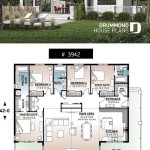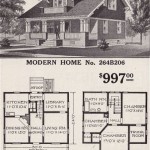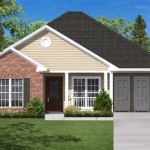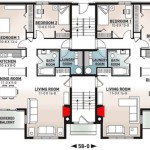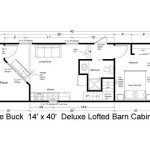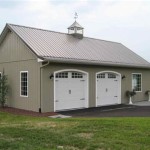Free Home Designs and Plans: A Comprehensive Guide
The prospect of building a new home or undertaking a significant renovation project can be simultaneously exciting and daunting. One of the initial and crucial steps in this process involves developing clear and comprehensive home designs and plans. While professional architectural services offer tailored solutions, individuals often seek free home designs and plans as a starting point for inspiration, cost estimation, and preliminary planning. This article explores the landscape of free home designs and plans, detailing their availability, limitations, and effective utilization.
Free home designs and plans are typically offered online by various sources, including: building material retailers, architectural software companies (often as trial versions or limited-functionality options), and DIY home improvement websites. These resources provide a range of styles and sizes, catering to various homeowner needs. The designs are often generic, intended to serve as a baseline for further customization and professional refinement.
The accessibility of these free resources offers several advantages. They allow homeowners to visualize potential home layouts and explore different architectural styles without incurring upfront costs. This initial exploration can be invaluable in solidifying design preferences and identifying essential features. Furthermore, free plans can serve as a useful tool for obtaining preliminary cost estimates, enabling homeowners to gauge the financial feasibility of their project before committing to extensive professional services.
Understanding the Scope and Limitations of Free Home Designs
It is crucial to understand that free home designs and plans are generally not construction-ready. They typically lack the detailed specifications and structural engineering necessary for obtaining building permits or guiding the construction process. These plans should be viewed as conceptual frameworks rather than complete blueprints. The absence of detailed structural information, electrical layouts, plumbing schematics, and local code compliance verification significantly limits their practical application in the construction phase.
Furthermore, free plans often lack the level of customization needed to address specific site conditions, such as soil type, topography, and orientation to the sun. These factors play a vital role in determining the structural integrity and energy efficiency of a home. Ignoring these site-specific considerations can lead to costly problems down the line, including foundation issues, inadequate drainage, and inefficient heating and cooling systems.
Another limitation of free home designs lies in the potential for outdated information or non-compliance with current building codes. Building codes are constantly evolving to reflect advancements in construction technology, safety standards, and energy efficiency requirements. Relying on outdated or non-compliant plans can result in construction delays, fines, and even the rejection of building permits. It is imperative to verify the compliance of any free plan with local building codes before using it for any construction purpose. This verification should ideally be conducted by a qualified architect or structural engineer.
Utilizing Free Home Designs Effectively
Despite their limitations, free home designs and plans can be effectively utilized as a valuable resource in the early stages of a home building or renovation project. The key is to approach them with a clear understanding of their intended purpose and to supplement them with professional expertise when necessary. Here are some strategies for utilizing free plans effectively:
Firstly, use the free designs as a source of inspiration and a tool for visualizing different layout options. Browse through various plans and styles to identify elements that resonate with personal preferences and lifestyle needs. Pay attention to the flow of spaces, the size and location of windows, and the overall aesthetic of the design. Create a collection of plans that represent different ideas and features that are appealing. This collection can then serve as a visual reference for discussions with architects and contractors.
Secondly, use the plans to develop a wish list of key features and specifications. Identify the number of bedrooms and bathrooms needed, the desired size and layout of the kitchen, and any special features such as a home office, a media room, or a large outdoor living space. Prioritize these features based on their importance and affordability. This wish list will help to guide the design process and ensure that the final plan meets the specific needs of the homeowner.
Thirdly, use the plans to obtain preliminary cost estimates. Contact local contractors or building material suppliers to get an idea of the cost of materials and labor. Keep in mind that these estimates will be based on generic specifications and may not reflect the actual cost of the project. However, they can provide a useful benchmark for assessing the financial feasibility of different design options. Remember to factor in costs associated with site preparation, permits, and potential unexpected expenses. It is prudent to add a contingency fund to the budget to cover unforeseen circumstances.
Transitioning from Free Plans to Professional Designs
Once a suitable free home design or a combination of design ideas has been identified, the next step is to engage the services of a qualified architect or structural engineer. These professionals can take the initial concept and transform it into a set of detailed, construction-ready blueprints. The architect will work closely with the homeowner to refine the design, address site-specific conditions, and ensure compliance with all applicable building codes. They will also provide guidance on material selection, energy efficiency strategies, and other aspects of the project.
The structural engineer will perform a detailed analysis of the design to ensure its structural integrity and safety. They will specify the appropriate foundation system, framing materials, and load-bearing elements to withstand the forces of nature and ensure the long-term stability of the home. The engineer will also prepare detailed drawings and specifications for the structural components of the building. This is a crucial step in ensuring the safety and durability of the home. Engaging a qualified structural engineer is essential for obtaining building permits and ensuring compliance with local regulations.
The architect and engineer will collaborate to create a comprehensive set of blueprints that include detailed floor plans, elevations, sections, and construction details. These blueprints will serve as the basis for obtaining building permits and guiding the construction process. They will also be used by contractors to prepare accurate cost estimates and ensure that the project is built according to the specifications. The level of detail and accuracy in these blueprints is crucial for the success of the project. Clear and comprehensive plans minimize the risk of misunderstandings, errors, and delays during construction.
Specific Considerations for Renovations Using Free Plans
When using free home designs for renovation projects, additional considerations come into play. It is essential to thoroughly assess the existing structure and identify any potential issues before proceeding with the renovation. This assessment should include a structural inspection to identify any signs of damage or deterioration, such as cracks in the foundation, water damage, or termite infestation. Addressing these issues before starting the renovation can prevent costly problems down the line.
Furthermore, it is important to understand the limitations of the existing structure and to ensure that the proposed renovation is compatible with the existing building. For example, adding a second story to a home may require significant structural modifications to the existing foundation and framing. It is crucial to consult with a structural engineer to determine the feasibility of the renovation and to design the necessary structural reinforcements. Failure to do so can compromise the structural integrity of the home and create safety hazards.
When renovating an older home, it is also important to be aware of potential environmental hazards, such as lead paint and asbestos. These materials were commonly used in older homes and can pose a health risk if disturbed during renovation. It is essential to test for these materials and to take appropriate precautions to protect workers and occupants during the renovation process. This may involve hiring a qualified environmental consultant to conduct testing and to develop a remediation plan.
Key Takeaways for Utilizing Free Home Designs and Plans
In summary, free home designs and plans offer a valuable starting point for home building and renovation projects. They provide a convenient way to explore different design options, visualize potential layouts, and obtain preliminary cost estimates. However, it is crucial to recognize the limitations of these plans and to supplement them with professional expertise when necessary. Free plans are not a substitute for detailed, construction-ready blueprints prepared by a qualified architect or structural engineer.
By using free plans as a source of inspiration and a tool for preliminary planning, and by engaging the services of qualified professionals to refine the design and ensure its structural integrity and code compliance, homeowners can leverage the benefits of free resources while minimizing the risks. This approach ensures that the final home design meets their specific needs, addresses site-specific conditions, and adheres to all applicable building codes. Careful planning and professional guidance are essential for a successful and satisfying home building or renovation experience.

Small House Plans Popular Designs Layouts

Sweet Home 3d Draw Floor Plans And Arrange Furniture Freely

Free Residential Home Floor Plans Evstudio

Small House Plans Popular Designs Layouts

Free 4 Bedroom House Plan N Plus Study Home Plans Display For Bed Floor

Dream Home Is Here Stunning Kerala Villa Design With 3 Bedroom Free Plan And Elevation

3d Floor Plans Renderings Visualizations Fast Delivery

Sweet Home 3d Draw Floor Plans And Arrange Furniture Freely

15 Home Designs Below 1000 Sqft In 4 To Lakhs With Free Plan Kerala Planners

Modern House Design Plans Imagination Shaper

